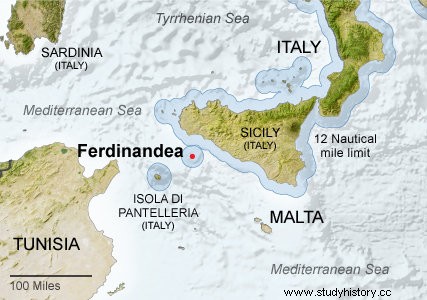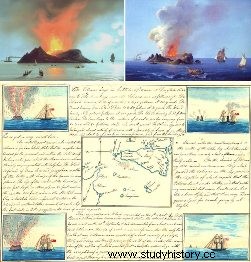The dispute over a territory by different European countries is nothing curious or anecdotal, but if the territory in question only existed for 5 months... things change. I am talking about Graham Island, Julia Island or Ferdinandea Island (Depending on which country of those who disputed its sovereignty name it). This island is nothing more than Empedocles , a large submarine volcano located 30 km south of the island of Sicily and whose peak is a few meters from the sea surface. Its name is due to the Greek philosopher. The first documented occurrence of an eruption of Empedocles, momentarily becoming an island, dates back to the First Punic War in the 3rd century BC.

Ferdinandea
But the reason for this article is due to the eruption that occurred in 1831, when overnight an islet appeared that, when it stopped spitting lava, had a length of 4 km, an area of 1.6 km², a height maximum of 60 meters above sea level and two small interior lakes. On August 2, 1831, when the island emerged from the sea had barely cooled, the English captain Humphrey Fleming Senhouse he set out from the island of Malta to plant the British flag and named it Graham Island . On August 17, a ship of King Ferdinand II of the Two Sicilies (kingdom made up of the union of Naples and Sicily, and under the sovereignty of the Spanish House of Bourbon that in 1861 will become part of Italy) arrived at the island, removed the British flag and planted its own, changing its name to Ferdinandea Island . On September 29, a French scientific mission planted its flag and named it île Julia .

Illustration of the French geologist Constant Prévost from 1831
That situation was about to create an international conflict over the sovereignty of the islet... which was resolved without any confrontation. The lava that the volcano spat out was composed of easily erodible material and the action of the waves and the wind caused the island to disappear on December 17... just five months after its appearance.
This island would still give for another curious situation. In April 1986, in the so-called Operation El Dorado Canyon , the US Air Force bombed Libya in retaliation for the bomb that exploded in a Berlin nightclub frequented by US soldiers. The bombers detected a shadow under the sea, which was none other than the island, and believing it to be a Libyan submarine... they bombed it.
